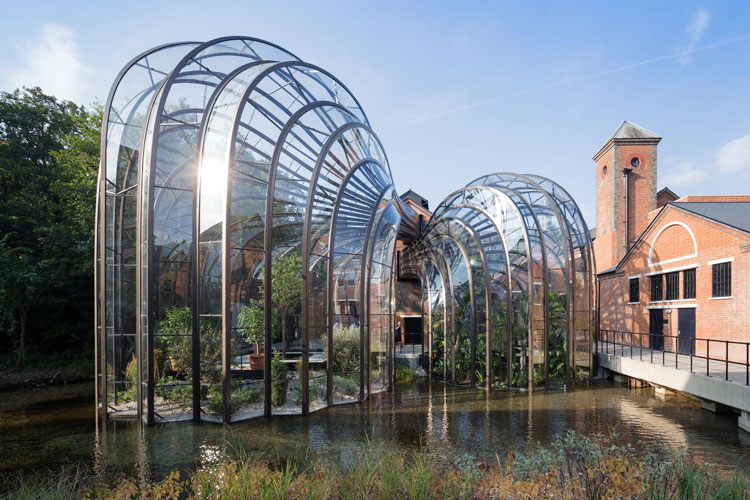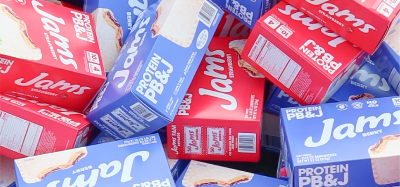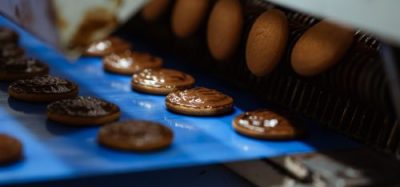Bombay Sapphire is leading the pack in gin innovation
- Like
- Digg
- Del
- Tumblr
- VKontakte
- Buffer
- Love This
- Odnoklassniki
- Meneame
- Blogger
- Amazon
- Yahoo Mail
- Gmail
- AOL
- Newsvine
- HackerNews
- Evernote
- MySpace
- Mail.ru
- Viadeo
- Line
- Comments
- Yummly
- SMS
- Viber
- Telegram
- Subscribe
- Skype
- Facebook Messenger
- Kakao
- LiveJournal
- Yammer
- Edgar
- Fintel
- Mix
- Instapaper
- Copy Link
Posted: 5 November 2020 | Bethan Grylls (New Food) | No comments yet
In an interview with New Food’s Editor, Bethan Grylls, Bombay Sapphire’s Master Distiller Dr Anne Brock explains how the renowned drink has stood the test of time, and the exciting gin trends and innovations coming to market.


In the late ’80s, the gin aisle was laden with green bottles. Among this emerald sea, Bombay Sapphire’s distinctive blue bottled gin stood proud. Although it may not seem like a radical move today, back then it was a bold statement and a testament of the brand’s nonconformist approach, still adopted today.
According to Dr Anne Brock, Bombay Sapphire’s Master Distiller, it is this unique way of doing things that has allowed the company to enjoy longstanding success; and this intrepid thinking is employed throughout its entire company, including its gin production process.
Gin: the Bombay Sapphire way
Unlike many distilleries, where all the ingredients are mixed together at the bottom of the still and left to boil, Bombay Sapphire uses a technique known as ‘vapour infusion’.
“We questioned whether these delicate ingredients would react well to such a harsh process [ie, boiling],” explained Dr Brock.
“Our botanicals don’t actually touch the liquid. Instead, we place them in a basket (of sorts) over the still. As we boil the alcohol, the ethanol steam rises up and through the basket, picking up all of those flavours. It’s still a form of extraction, but under very different conditions.”
The distillery has a Master of Botanicals who deals with the botanicals supplier directly, rather than via a broker. “Having that connection is quite unique in the gin world,” said Dr Brock.
In the late ’80s, the gin aisle was laden with green bottles. Among this emerald sea, Bombay Sapphire’s distinctive blue bottled gin stood proud. Although it may not seem like a radical move today, back then it was a bold statement and a testament of the brand’s nonconformist approach, still adopted today.
According to Dr Anne Brock, Bombay Sapphire’s Master Distiller, it is this unique way of doing things that has allowed the company to enjoy longstanding success; and this intrepid thinking is employed throughout its entire company, including its gin production process.
Gin: the Bombay Sapphire way
Unlike many distilleries, where all the ingredients are mixed together at the bottom of the still and left to boil, Bombay Sapphire uses a technique known as ‘vapour infusion’.
“We questioned whether these delicate ingredients would react well to such a harsh process [ie, boiling],” explained Dr Brock.
“Our botanicals don’t actually touch the liquid. Instead, we place them in a basket (of sorts) over the still. As we boil the alcohol, the ethanol steam rises up and through the basket, picking up all of those flavours. It’s still a form of extraction, but under very different conditions.”
The distillery has a Master of Botanicals who deals with the botanicals supplier directly, rather than via a broker. “Having that connection is quite unique in the gin world,” said Dr Brock.
Bombay Sapphire’s juniper berries come from wild bushes grown on Tuscan hills, which are famous for their quality berries due to the ideal climate. The harvesters, although supplying a multinational gin company, represent a humble Tuscan business. “They get their license from the council every Autumn and trot up the hills to forage for juniper. It’s all hand-picked too,” noted Dr Brock.
“Juniper is obviously the key ingredient in any gin, but a great gin involves a range of carefully selected botanicals,” she added. “What Bombay Sapphire has done exceptionally well is create a ‘balanced’ recipe. We use 10 botanicals, which complement one another to produce a well-rounded spirit.”
By ‘balanced’, Dr Brock means that you are able to get a sense of each botanical without any one overpowering another.
“As Master Distiller it is my responsibility to quality check every bottle of Bombay Sapphire.” Part of that role is to ensure product consistency, something which climate change is making difficult.
“All our flavour comes from natural ingredients, but harvests can vary year-on-year. Whether it’s a poor harvest or a good one, it is hard to manage; this is because you want your botanicals to taste the same every time.”
To accommodate this variability, the distillery will store some of the crops from previous harvests for use at a later date. These are then blended until the appropriate result is achieved – a process that involves a significant amount of lab testing to ensure the variations have been dealt with.
Traditionally, distilling was not a sustainable process, but some companies, including Bombay Sapphire, have worked hard to help make their processes more environmentally friendly.
In fact, the Bombay Sapphire distillery at Laverstoke Mill became the first distillery and refurbishment to achieve an ‘Outstanding’ BREEAM award for sustainability in 2014 (Building Research Establishment Environmental Assessment Methodology Industrial Award). Furthermore, working with Heatherwick Studio, Bombay Sapphire sympathetically renovated a 300-year-old paper mill, Laverstoke Mill, into a sustainable distillery. The design measures include:
- Renewable and low-carbon energy provided by photovoltaic array and a hydro-electric turbine in the River Test
- A Biomass boiler, which provides heat and hot water using local, sustainably sourced wood chips as a fuel source
- Use of recycled materials. Throughout construction, key building materials, including bricks and roof tiles, were recycled and reused from demolished buildings
- Rainwater harvesting and flow restricted water devices specified throughout the site
- All 10 botanicals used to make Bombay Sapphire will also soon be certified as ‘sustainable’ by Ecocert – a first for any gin, according to the company.
The gin explosion
No doubt most will be aware of the rise of gin and, according to Dr Brock, there are several drivers for this. The first she pointed to is consumer demand for products that are new and exciting. “Consumers want something they can explore and learn about; they want to challenge their taste buds.”
This curiosity is spurred on by a strong worldwide push for more sustainable practice.
“Consumers care about where their products come from; they want to understand more about this and the production process. The distillery boom and option to visit distilleries has helped satisfy this.” She noted that consumers are no longer looking for cheap booze to get them drunk on a Friday night. “Today’s shopper is interested in premium; they care about quality and the choices behind the flavours.”
She added, “The recent pandemic has also meant that we’re spending a lot more time at home. This has given rise to creativity – the homemade cocktail revolution. Gin is a great spirit to play with, so we’re seeing customers at home making Bombay Sapphire concoctions.”
Catering to this trend, the company has launched Bombay Creations – a set of small gin liquors that shoppers can use to make their own cocktails.
“It’s all about personalisation; making a drink to your own tastes.”
The pink gin phenomenon
Sales of pink gin in 2019 up to mid-May were £392 million, representing an eight-fold increase on the previous 12 months,1 according to insight and data consultancy CGA.
“What was great about this trend was that it brought people into the gin category who wouldn’t have necessarily drunk gin before,” said Dr Brock. “Pink gin is a more accessible version of the classic dry gin because of those summery, fruity, sweet flavours. Saying this, I do believe pure London dry has longer staying power. What we’ll begin to see with pink gin, and other subcategories, is further diversification and innovation, moving away from the traditional raspberry, strawberry flavours that began the trend.”
Predicting this movement – and wanting to leverage the pink gin trend without being a follower – Bombay Sapphire launched Bombay Bramble. A combination of raspberry and blackberries, this new beverage is a “twist on the familiar”. Unlike most pink gins, it does not include refined sugar. Instead, Bombay Bramble relies on the natural sweetness of the fruit and so retains the dryness of traditional gin.
Convenience
Another beverage trend referenced by Dr Brock is convenience, but “without compromising quality”. The ready-to-drink cocktail is starting to see a rise in popularity, but it is not without its challenges.
“A lot of the top, bright, lovely gin notes that we like don’t take too well to sitting around in tonic water for a long time,” she explained. “What you will have seen previously is processed pre-mixed drinks made in a lab. So, it hasn’t been real gin in that can, it’s been different flavourings and other things which have tried to mimic that fresh G&T taste.”
Bombay sapphire has just released its own gin and tonic in a can, which Dr Brock said avoids such pitfalls. “Making it taste like a fresh Bombay Sapphire and tonic was not easy, but we managed it.” Without being at liberty to divulge the secret to New Food, Dr Brock shared that it took extensive R&D and shelf-life testing.
What’s next?
Of course, it’s an interesting time for any business right now but Dr Brock also believes it to be an exciting time too.
“Gin is still thriving, and I believe that there is much innovation within this category still to come. As far as Bombay Sapphire is concerned, we’re the fastest growing premium gin within one of the fastest growing spirit categories, so I’m feeling really positive about the future. I’m excited to see what’s coming next.”
Dr Anne Brock


Reference
- https://www.cga.co.uk/wp-content/uploads/2019/07/ CGA_172-Pink-Gin-Report.pdf
Issue
Related topics
Beverages, Flavours & colours, Ingredients, New product development (NPD), Product Development, Research & development, Technology & Innovation









